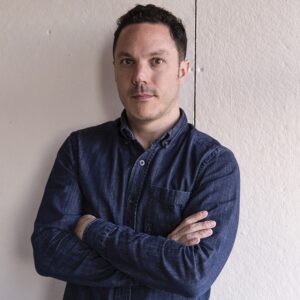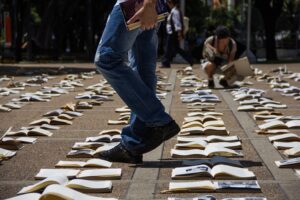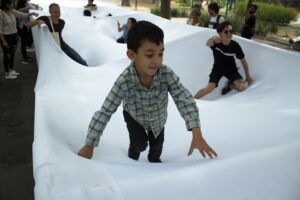For Miguel Braceli, Provincetown is at once extraordinarily real and as fantastic as a fairy tale. His studio space at the Fine Arts Work Center is more “gathering place” than workshop. His works resist the limitations of any one medium; they revel in fabrics and photography. His upcoming performance, titled True Love’s Kiss, is being meticulously planned but will unfold at the whim of the moment.

As the sun sets on Saturday, March 23, a cavalcade of people carrying a long length of tulle will proceed down Provincetown’s West End jetty and give Braceli a kiss. The performance is part of a larger project, A Queer Fairy Tale in Provincetown.
Kisses have always frightened Braceli, he says. But he’s fascinated by the way they mark watershed moments in fairy tales. “The kiss in a fairy tale has this magical power to change everything,” he says. “A princess comes alive.”
For Braceli, place is character and subject as much as setting. Before arriving at FAWC as a fellow, he had only a vague idea of what he wanted to generate here. “I came to Provincetown with the hope of creating my first queer piece,” Braceli says. It felt like “something I owe myself.”
The contours of the project materialized after he became acquainted with the town’s idiosyncrasies: its architecture, wintry social ecosystem, and ardent sense of community. Braceli says he has found a sense of belonging here — the first time he has experienced that at an artist residency.
“On a Sunday you’re sad, and you call your friends from town, and you go make dinner,” he says. “That’s something you can do in a place you’ve been living, at the very least, for five years.”
His fairy tale is informed by a project he embarked on early in his fellowship called “Dear Daddy,” in which he interviewed older queer people “to learn about love and life, somehow recreating the figure of my father to get advice I never had,” he says. Braceli’s also been collaborating with artist and cartographer Mark Adams on a “Map of Love.”

In True Love’s Kiss, Provincetown will be a main character. The performance is meant to challenge a deficit from Braceli’s childhood: his earliest learning came from fairy tales, he says, but he never recognized himself in them: “I’m doing a project that I would love to have had as a reference when I was a kid.”
Braceli was born in Carabobo, Venezuela and studied architecture at the Central University of Venezuela in Caracas. Having an architecture practice felt impossible in Venezuela’s political unrest and social upheaval, and Braceli turned toward activism. His work became increasingly performative: at some point, he says, “I understood that what I was doing was art.”
In 2013, Braceli’s Biblioteca Abierta (free library) “reprogrammed” public spaces by leaving books splayed open in arresting patterns and numbers. “While the government was giving free food as a mechanism of control, this project was providing free books as a form of emancipation,” he says. Three years later, the project appeared on the streets of Barrio Pajaritos, a poor enclave in the Caracas subdivision of Chacao. His projects use art and communal participation to “activate public spaces,” he says. “A collaborative experience, working with other people and with different materials, changes reality for a few seconds and at the same time creates new memories.”

Braceli left Venezuela in 2018 for an M.F.A. at the Maryland Institute College of Art, and he’s continued working internationally. In 2020, his exhibition Monumentos Horizontales epitomized the unexpected turns of collective performance. Working with students in Guadalajara, Mexico, he organized a group walk with a life-size horizontal obelisk made of elastic fabric. When the group arrived in a park, kids clambered onto it, and the fabric unexpectedly became a playground.
Braceli is three years into a collective project “reactivating” and honoring the work of Gertrud Louise Goldschmidt, known as Gego, a prolific Venezuelan-German sculptor and artist. Since 2021, participants have been sending in works addressing her Reticulárea, an installation linking lines in space. With submissions spanning the globe, the project addresses the Venezuelan diaspora. He’ll head next to Tulsa, Okla. for the three-year Tulsa Artist Fellowship.
Braceli’s studio at FAWC is somewhat bare. It has a ring light and 14 nails he mounted in hopes of experimenting with how tulle falls. In one corner, a tiered tulle skirt that the performer Saltine will wear as she chaperones the fairy tale procession sits upright in a chair. There are maps on the table with geometric directions that Braceli says are preliminary plans for the aerial angles a drone will take in documenting the jetty spectacle.
As Braceli talks about the gaps between performance and documentation, he’s drawing lines, circles, and arrows summoning each other like an abstracted concept map. True Love’s Kiss will unfold in real time, informed by how the wind billows the tulle and by who responds to the fairy tale’s open invitation.
“It’s a conversation with the landscape,” he says, “with the people, with the contingency of what happens.”



